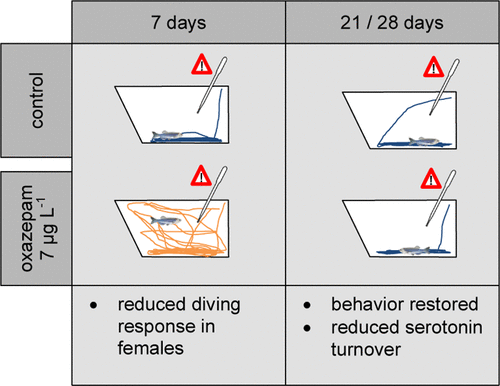当前位置:
X-MOL 学术
›
Environ. Sci. Technol.
›
论文详情
Our official English website, www.x-mol.net, welcomes your
feedback! (Note: you will need to create a separate account there.)
Chronic Exposure to Oxazepam Pollution Produces Tolerance to Anxiolytic Effects in Zebrafish (Danio rerio).
Environmental Science & Technology ( IF 10.8 ) Pub Date : 2020-01-24 , DOI: 10.1021/acs.est.9b06052 Laura E Vossen 1 , Daniel Cerveny 2, 3 , Marcus Österkrans 1 , Per-Ove Thörnqvist 1 , Fredrik Jutfelt 4 , Jerker Fick 2 , Tomas Brodin 5 , Svante Winberg 1
Environmental Science & Technology ( IF 10.8 ) Pub Date : 2020-01-24 , DOI: 10.1021/acs.est.9b06052 Laura E Vossen 1 , Daniel Cerveny 2, 3 , Marcus Österkrans 1 , Per-Ove Thörnqvist 1 , Fredrik Jutfelt 4 , Jerker Fick 2 , Tomas Brodin 5 , Svante Winberg 1
Affiliation

|
Environmental concentrations of the anxiolytic drug oxazepam have been found to disrupt antipredator behaviors of wild fish. Most experiments exposed fish for a week, while evidence from mammals suggests that chronic exposure to therapeutic concentrations of benzodiazepines (such as oxazepam) results in the development of tolerance to the anxiolytic effects. If tolerance can also develop in response to the low concentrations found in the aquatic environment, it could mitigate the negative effects of oxazepam pollution. In the current study, we exposed wild-caught zebrafish to oxazepam (∼7 μg L-1) for 7 or 28 days and evaluated behavioral and physiological parameters at both time points. Females showed reduced diving responses to conspecific alarm pheromone after 7 days, but not after 28 days, indicating that they had developed tolerance to the anxiolytic effects of the drug. Zebrafish males were not affected by this oxazepam concentration, in line with earlier results. Serotonin turnover (ratio 5-HIAA/5-HT) was reduced in exposed females and males after 28 days, indicating that brain neurochemistry had not normalized. Post-confinement cortisol concentrations and gene expression of corticotropin-releasing hormone (CRH) were not affected by oxazepam. We did not find evidence that chronically exposed fish had altered relative expression of GABAA receptor subunits, suggesting that some other still unknown mechanism caused the developed tolerance.
中文翻译:

长期暴露于奥沙西m污染会产生对斑马鱼抗焦虑作用的耐受性(Danio rerio)。
已经发现环境浓度的抗焦虑药奥沙西concentrations会破坏野生鱼的抗捕食行为。大多数实验将鱼暴露一周,而来自哺乳动物的证据表明,长期暴露于治疗浓度的苯二氮卓类药物(例如奥沙西m)会导致对抗焦虑作用的耐受性增强。如果对水生环境中发现的低浓度也能产生耐受性,则可以减轻奥沙西m污染的负面影响。在当前的研究中,我们将野生捕获的斑马鱼暴露于奥沙西((约7μgL-1)中7或28天,并评估了两个时间点的行为和生理参数。女性在7天后(但在28天后)并未显示出对特定警报蛋白信息素的跳水反应减少,表明他们对药物的抗焦虑作用产生了耐受性。与早期的结果一致,斑马鱼雄性不受该奥沙西m浓度的影响。28天后,暴露的女性和男性的5-羟色胺周转率(5-HIAA / 5-HT比率)降低,表明脑神经化学尚未恢复正常。限制用药后皮质醇浓度和促肾上腺皮质激素释放激素(CRH)的基因表达不受奥沙西m的影响。我们没有发现证据表明长期暴露的鱼类已经改变了GABAA受体亚基的相对表达,这表明其他一些仍未知的机制导致了耐受性的发展。28天后,暴露的女性和男性的5-羟色胺周转率(5-HIAA / 5-HT比率)降低,表明脑神经化学尚未恢复正常。限制用药后皮质醇浓度和促肾上腺皮质激素释放激素(CRH)的基因表达不受奥沙西m的影响。我们没有发现证据表明长期暴露的鱼类已经改变了GABAA受体亚基的相对表达,这表明其他一些仍未知的机制导致了耐受性的发展。28天后,暴露的女性和男性的5-羟色胺周转率(5-HIAA / 5-HT比率)降低,表明脑神经化学尚未恢复正常。限制用药后皮质醇浓度和促肾上腺皮质激素释放激素(CRH)的基因表达不受奥沙西m的影响。我们没有发现证据表明长期暴露的鱼类已经改变了GABAA受体亚基的相对表达,这表明其他一些仍未知的机制导致了耐受性的发展。
更新日期:2020-01-24
中文翻译:

长期暴露于奥沙西m污染会产生对斑马鱼抗焦虑作用的耐受性(Danio rerio)。
已经发现环境浓度的抗焦虑药奥沙西concentrations会破坏野生鱼的抗捕食行为。大多数实验将鱼暴露一周,而来自哺乳动物的证据表明,长期暴露于治疗浓度的苯二氮卓类药物(例如奥沙西m)会导致对抗焦虑作用的耐受性增强。如果对水生环境中发现的低浓度也能产生耐受性,则可以减轻奥沙西m污染的负面影响。在当前的研究中,我们将野生捕获的斑马鱼暴露于奥沙西((约7μgL-1)中7或28天,并评估了两个时间点的行为和生理参数。女性在7天后(但在28天后)并未显示出对特定警报蛋白信息素的跳水反应减少,表明他们对药物的抗焦虑作用产生了耐受性。与早期的结果一致,斑马鱼雄性不受该奥沙西m浓度的影响。28天后,暴露的女性和男性的5-羟色胺周转率(5-HIAA / 5-HT比率)降低,表明脑神经化学尚未恢复正常。限制用药后皮质醇浓度和促肾上腺皮质激素释放激素(CRH)的基因表达不受奥沙西m的影响。我们没有发现证据表明长期暴露的鱼类已经改变了GABAA受体亚基的相对表达,这表明其他一些仍未知的机制导致了耐受性的发展。28天后,暴露的女性和男性的5-羟色胺周转率(5-HIAA / 5-HT比率)降低,表明脑神经化学尚未恢复正常。限制用药后皮质醇浓度和促肾上腺皮质激素释放激素(CRH)的基因表达不受奥沙西m的影响。我们没有发现证据表明长期暴露的鱼类已经改变了GABAA受体亚基的相对表达,这表明其他一些仍未知的机制导致了耐受性的发展。28天后,暴露的女性和男性的5-羟色胺周转率(5-HIAA / 5-HT比率)降低,表明脑神经化学尚未恢复正常。限制用药后皮质醇浓度和促肾上腺皮质激素释放激素(CRH)的基因表达不受奥沙西m的影响。我们没有发现证据表明长期暴露的鱼类已经改变了GABAA受体亚基的相对表达,这表明其他一些仍未知的机制导致了耐受性的发展。











































 京公网安备 11010802027423号
京公网安备 11010802027423号